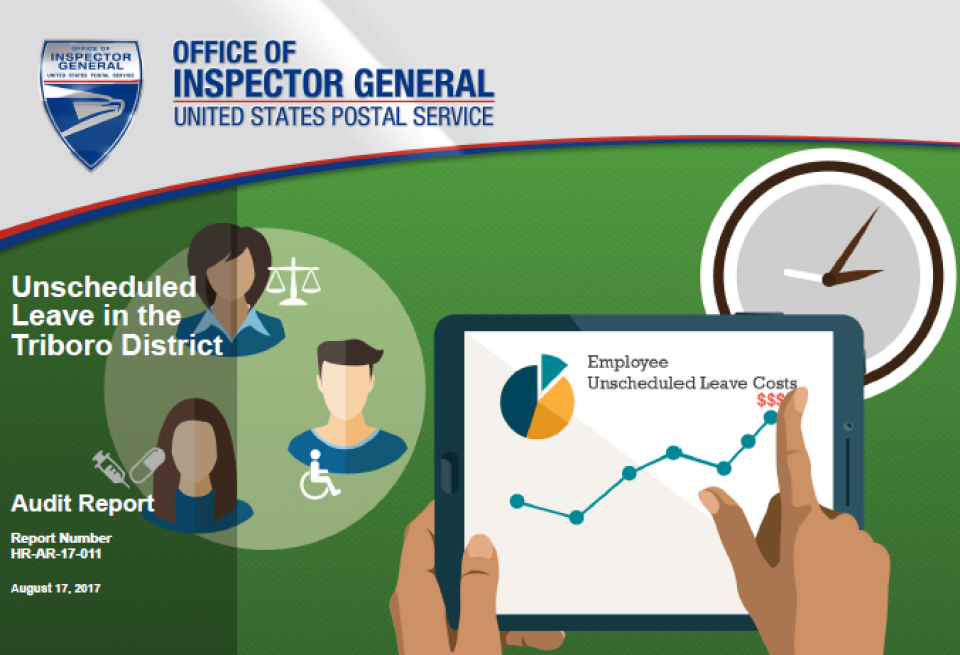Unscheduled Leave in the Triboro District
Background
The U.S. Postal Service categorizes unscheduled leave as any absence from work that is not requested or approved in advance. Unscheduled leave could contribute to increased compensation expenses by requiring management to increase workhours and overtime hours.
The OIG developed a Human Resource Risk Model (risk model) to monitor key Postal Service metrics, including unscheduled leave that could potentially affect productivity, efficiency, costs, and employee morale. In fiscal year (FY) 2016, Quarter 1, the risk model identified the Postal Service’s Triboro District in the Northeast Area as having the sixth highest percentage of unscheduled leave and fifth highest percentage in Quarters 2 through 4. This is fourth in a series of audits in districts with high unscheduled leave activity.
Our objective was to assess the management of unscheduled leave in the Triboro District and identify opportunities to reduce unscheduled leave and its associated costs.
What the OIG Found
The Triboro District did not adequately manage excessive unscheduled leave, which could be potentially mitigated to acceptable levels by appropriately completing and retaining required forms, enforcing disciplinary actions, and providing sufficient supervisory training.
We determined employees with a combined 69 or more occurrences of unscheduled leave during FYs 2015 and 2016 to be excessive. In FY 2016, 525 of the district’s 9,495 employees (or 6 percent) had excessive unscheduled leave, which was 35 percent (298,387 of 858,657) of total unscheduled leave hours.
In FY 2016, the top three unscheduled leave types recorded for the 525 employees were absent without leave, sick leave, and full day leave without pay, which represented 85 percent (255,098 of 298,387) of their unscheduled leave hours taken.
This occurred because Postal Service supervisors did not properly complete, approve, and maintain Postal Service Forms 3971, Request for or Notification of Absence, which they are required to complete when employees return to work; they did not always review Postal Service Form 3972, Absence Analysis, to identify irregularities in attendance; they did not take appropriate disciplinary action against employees with excessive leave; and they did not receive sufficient training on the unscheduled leave systems/processes or the disciplinary process.
At a site with low unscheduled leave occurrences managers explained their site uses an Excel spreadsheet to track unscheduled leave, hold monthly attendance reviews with employees after they return to work from leave, and document the reviews.
In June 2016, district management formed a committee to review and analyze chronic and/or prolonged use of leave without pay and to improve employee availability. However, based on the exceptions identified, the district could enhance its oversight process to ensure that supervisors are following established guidance and disciplinary action district-wide.
In addition, management began implementing corrective actions by initiating reviews at three facilities. District management analyzed enterprise Resource Management System/attendance records and held discussions with supervisors and managers regarding completing and retaining PS Forms 3971, attendance policies, and reviewing sick/Family Medical Leave Act leave and unscheduled leave occurrences, and key indicator reports. However, additional actions are warranted to fully address the factors that contributed to excessive unscheduled leave use.
In FY 2016, our risk model identified 6 percent of employees in the Northeast Area with 20 or more unscheduled leave occurrences per 100 employees, whereas the Triboro District had 12 percent. By reducing the 525 employees with excessive unscheduled leave in Triboro District to the Northeast Area percentage, the Triboro District would have reduced their excessive unscheduled leave hours by 49 percent (or 92,710 hours). These hours cost the Postal Service about $1.9 million in labor and overtime costs during FY 2016.
What the OIG Recommended
We recommended management issue guidance to managers and supervisors to reiterate policies in using the enterprise Resource Management System to manage and document unscheduled leave and to initiate disciplinary actions when appropriate; require managers and supervisors to attend training; and enhance the current district review process to include monitoring protocols to promote supervisor accountability.

